Scroll down to read pages
What I have here are parts of an essay that ran as a series in This Week on Okinawa.
I had torn the pages out and saved them for the essay but didn't keep the covers
so I don't know what issues they came from. They came in 5 separate issues -
two of which are in such terrible shape (water damage and the other is crumpled
as it was stuffed in the bottom of the case - tsk!) that I can't photograph them.
In their place I'll add the text where it should be in the series.
Okinawa: Ten Years Later
an essay by Dr. Willard Hanna
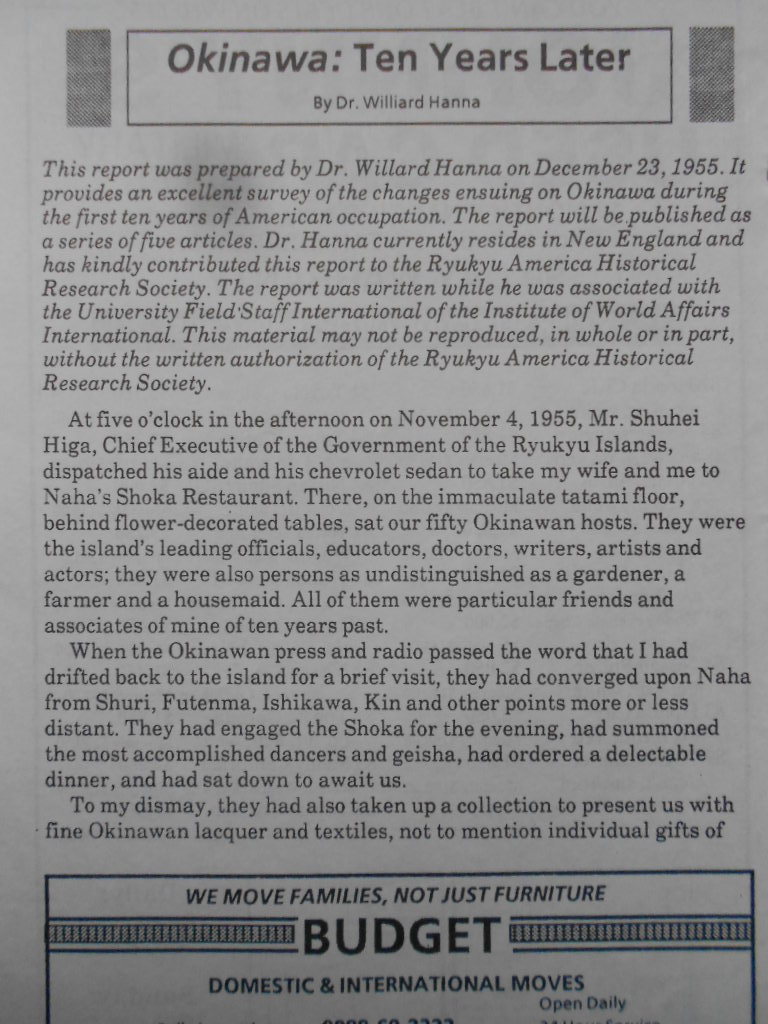
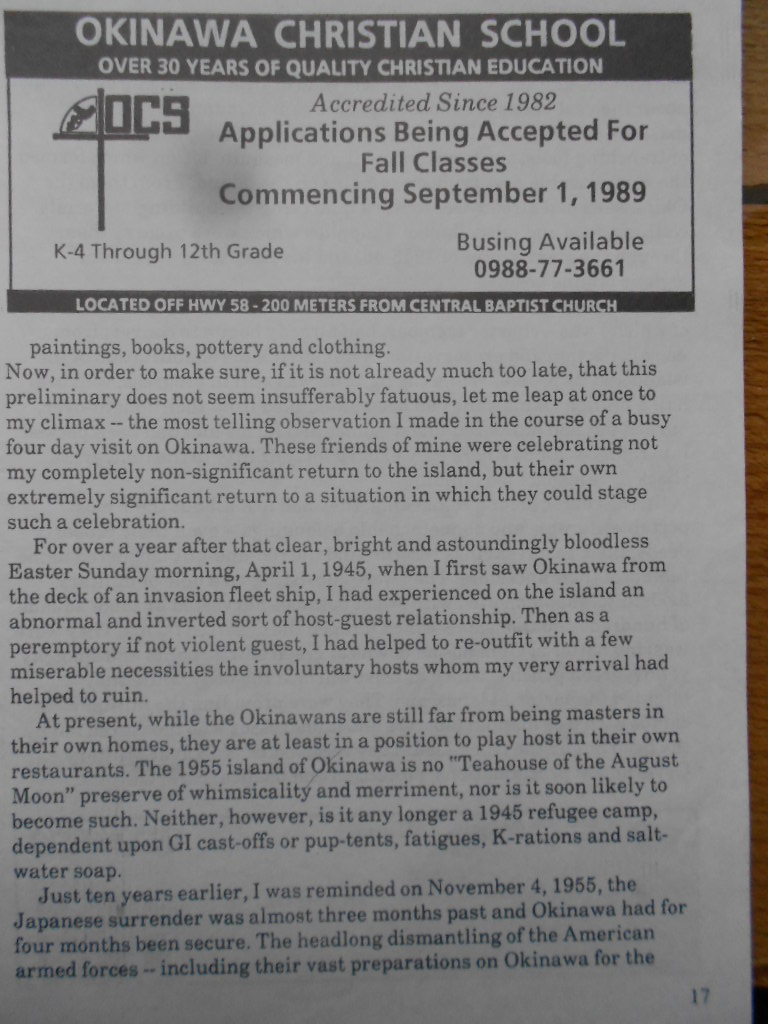
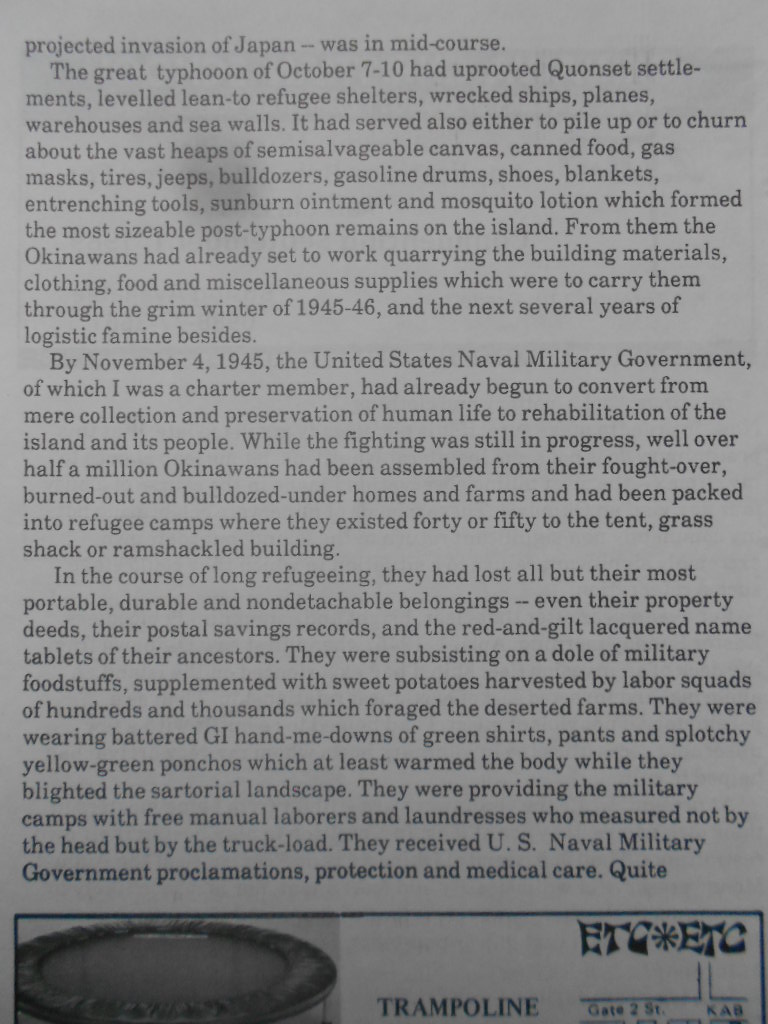
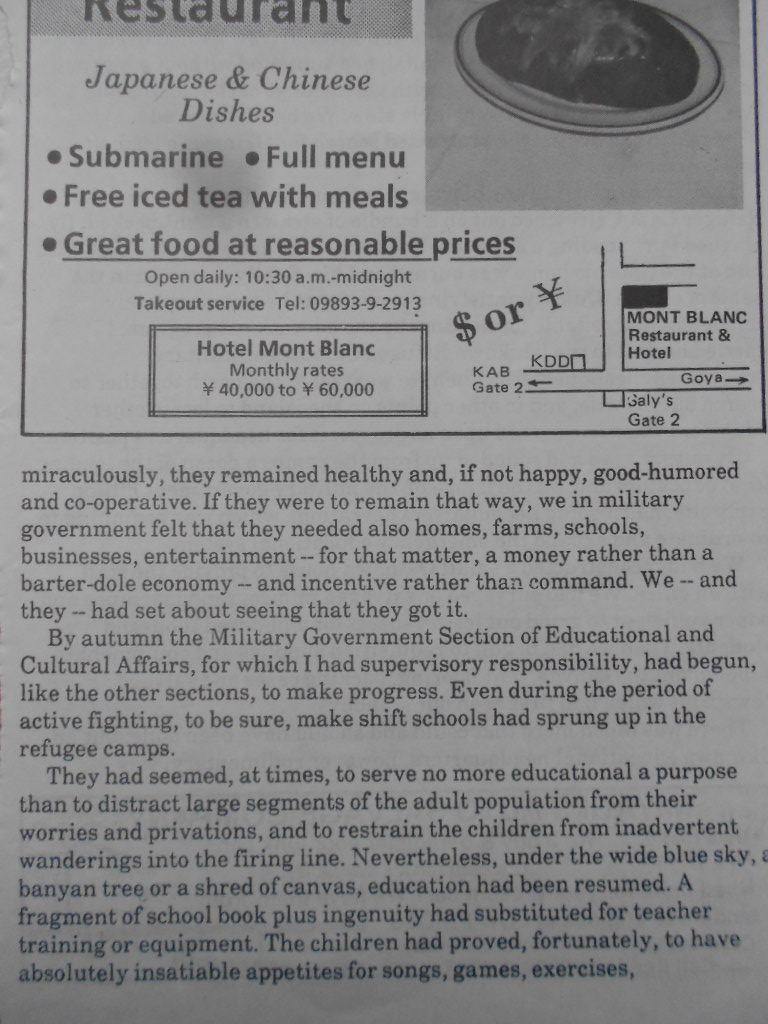
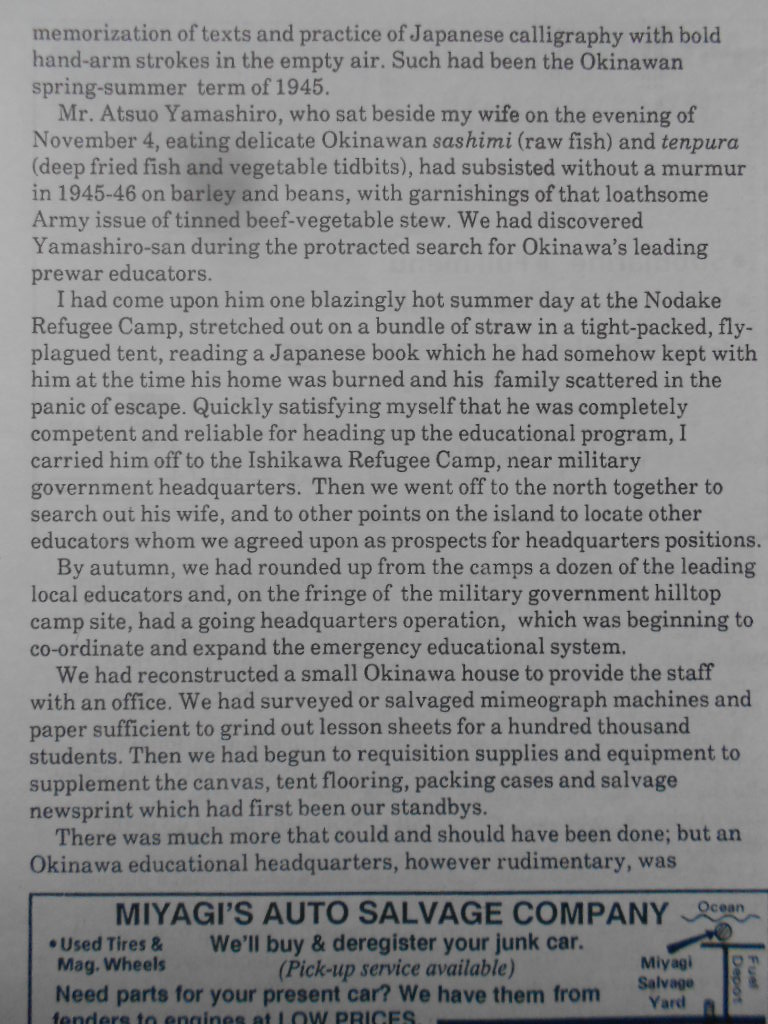
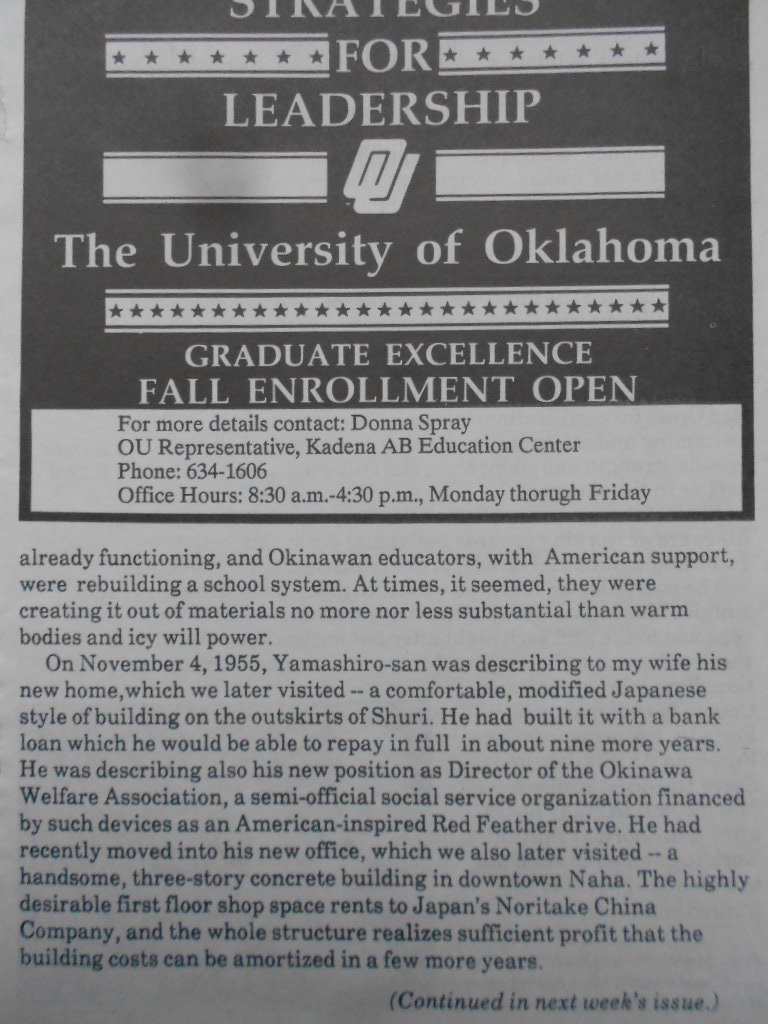
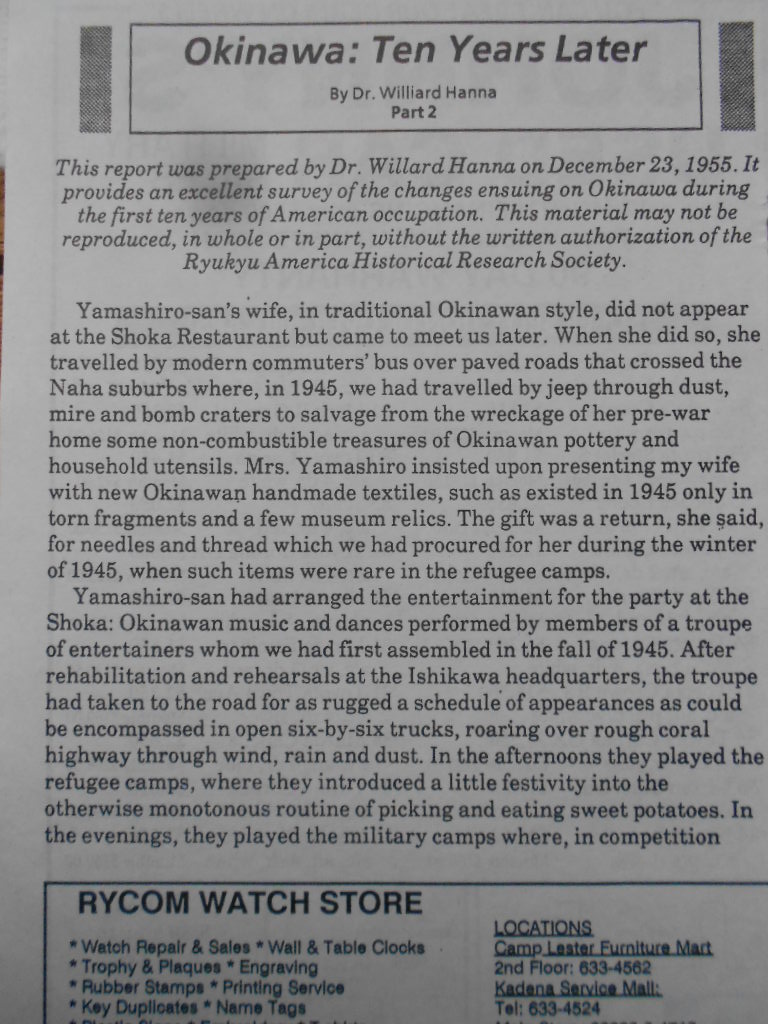
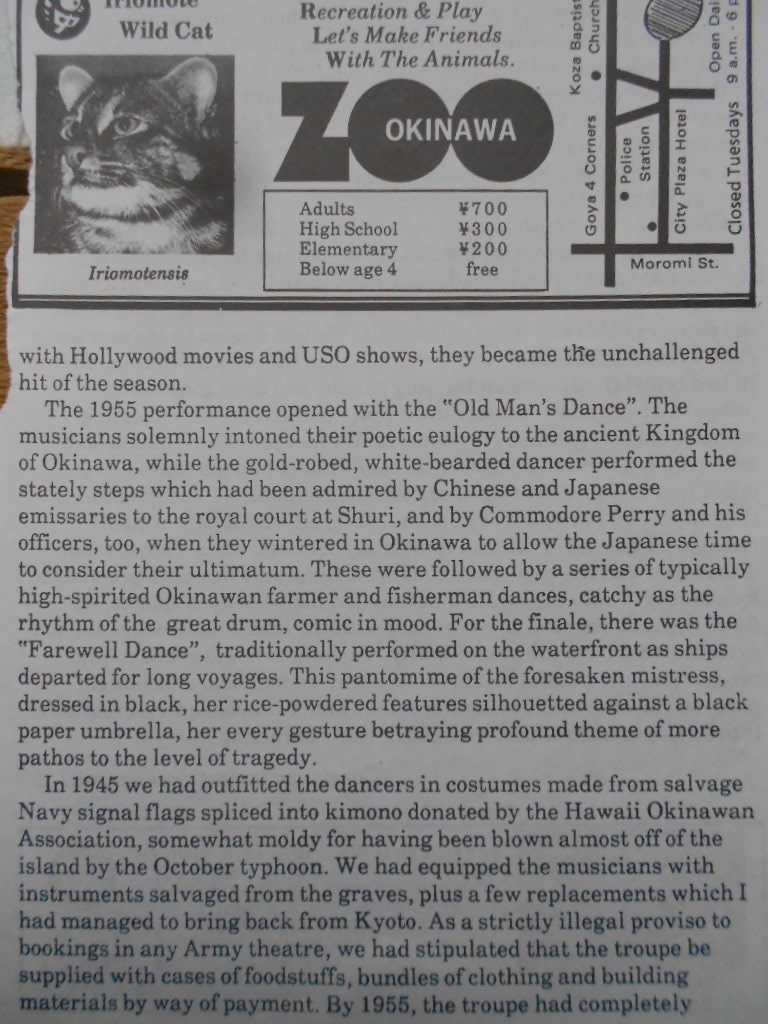
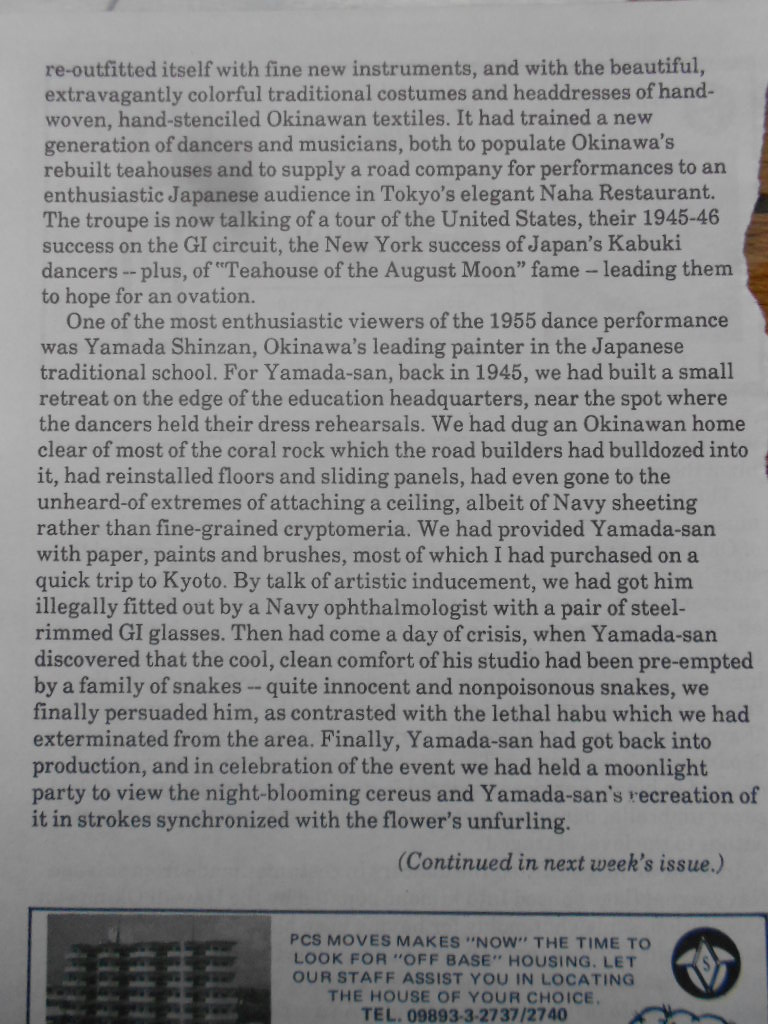
|
The day after our Shoka Restaurant reunion, we visited Yamada-san at Futenma. Close to the newly-renovated Futema Shrine -- from which, in 1945, we just barely managed to deflect the bulldozers--Yamada-san has acquired his own prosperity. On it he has built a beautiful Japanese house and garden, also a detached studio, and also, to the amazement of his colleagues, a Western-style restaurant which his very competent wife is operating at what seems to be a quite satisfactory profit. Yamada-san has recently been practicing both sculpture and wood-carving, in addition to painting. He has just received a commission to do a striking series of carved panels for the RYCOM officer's club. He has sent paintings to postwar exhibitions in Japan, has published two volumes of reproductions of his postwar works, and has made artistic pilgrimages to the off-lying islands in search of subjects unaltered by the changes which have overtaken his own island and his own way of life. He has developed a steady and profitable clientele among the American community whose insatiable taste for genuine signed Yamadas assures him a considerably more attractive artistic and financial future than that which threatened him in 1945. Cigarette-bearing would-be clients then commonly wished to commission him to paint red, gold and lavender dragons on green bush jackets.
By the spring of 1946, in addition to Yamada-san, we had managed to rehabilitate half a dozen other artists of real note. We had staged the first postwar Okinawan art exhibition, at which paintings were sold to GI's at prices which made art an eminently respectable profession. The artists were thus ushered back into the newly-restored monetary economy as distinctly upper-class citizens. These other artists were also among the more affluent of our 1955 hosts, and in the course of our island travels we visited several of them in their new studios in the Shuri-Naha area, to see their work. Oshiro-san, Okinawa's leading painter in oils in the Western manner, had just sent off for exhibition in Tokyo a pair of extremely powerful canvasses which show a Guaguin-like treatment of the bold shapes and brilliant colors of his subtropical island. Omine-san, who had recently returned from an artist's tour of Japan, is producing serenely beautiful paintings of the traditional Okinawan landscape, where red tile roof and high coral wall, lighted by mellow sunshine and shadowed by dense hedges, are picked out against mountain-seascape backgrounds. Yamamoto-san is teaching sketching at the University, and collecting archeological fragments.
One of the most exuberant of our November 4, 1955 hosts were Omine Kaoru, now the prosperous managing director of the Daito Sugar Company, one of Okinawa's largest commercial enterprises. In 1945-46 Omine-san was the curator of the small museum which the Section of Education and Cultural Affairs put together to preserve and to display what little had survived of the folk art treasures of the island. Before the shells had stopped going off, we had got busy collecting prize specimens of Okinawan pottery, laquer, textiles and of the other arts and crafts which have made the island famous among Japanese connoisseurs. Largely from the rubble and corpse-littered caves of Shuri Castle Hill, we managed to bring together a collection which included rare items from the prewar Shuri Castle Museum. From the Buddhist Temple at Kin we spirited off for safe-keeping the images, red-lacquered altar tables and other fixtures, enjoining the commander of each new military unit encamped in the area that he would have international law to reckon with if the temple itself got bulldozed under the Kin air-strip which, in consequence, now bows slightly around the temple grounds.
Omine-san, with a small group of assistants, made day-long trips by truck to all parts of the island to collect whatever was salvageable and portable in the way of arts and crafts. He brought in segments of stone lanterns and set the stone masons to work chipping replacement sections. Out of the ruins of the Enkaku Buddhist Temple at Shuri, he sorted fragments of carved and painted wooden beams and animal figures. From the green, algae-covered pond into which the temple ruins had slipped, he dredged up carved stone panels that fitted together into an historic bridge. From Shuri Castle ruins he excavated and reassembled fragments of the carved stone monsters which had guarded the entrance to the audience chamber. At the austerely beautiful tomb of the Kings of Okinawa near Shuri, he tidied up bones and burial urns and cemented up bombed-out roof corners, removing only symbolic stone fragments for museum display.
Then, one cold winter day, in an excess of antiquarian zeal, he fetched in out of the far north the burial urn of some ancient Okinawan nobleman, a piece of primitive pottery which would have no doubt delighted the archaeologists. Within hours of the arrival of the urn a sudden gale struck the area. The new electrical generator was knocked out and several workmen were injured. Other workmen began to complain of mysterious ailments and accidents; the servant girls began to mutter about curses and ghosts. After consultation with day laborers and learned educators, Omine-san hustles the anjin's urn back to the barren north hills. The museum lost a prize specimen but remained in operation, visited by many thousands of GI's who marvelled at the undreamed-of evidences of Okinawan civilization and culture, and presently by many more thousands of Okianwans who were comforted to be reminded that Okinawans had not always worn khaki, nor eaten off tin mess gear, nor lived in pine-and-straw sheds.
The greatest treasures of the museum were four tremendous bronze bells of ancient but uncertain provenance, probably cast in Korea, perhaps cast by Korean artisans in Okinawa. These tremendous bells survived bombing, burning, shooting and--often the most formidable hazards of war-time Okinawa--military souveniring. We dug two of the bells out of the ruins of the Shuri Castle area shortly after the fighting ended and arranged for their delivery to Military Government Headquarters for what seemed at the time rather unnecessary safekeeping. Then, almost within hours, there occured three developments of disparate but related significance. First, I retired to a Navy hospital with a case of jaundice which kept me otherwise engaged for about a month. Second, copies of "A Bell for Adano" began to arrive on the island and to give ideas to Military Government officers. Third, someone recalled that at the Naval Academy in Annapolis there hangs a similar but smaller bell. It had been presented by the Regent of Okinawa to Commodore Perry; transported by Perry to Naha over a road especially widened and reinforced for its passage; shipped off to the States along with a slab of Okinawan limestone presented by the Regent for inclusion in the then unfinished Washington Monument; bequeathed by the Commodore to his widow; bestowed by her upon the Academy and at last prominently displayed on the Academy grounds and rung for such important occasions as, for instance, Navy football victories over the Army.
When I emerged from the hospital and cast about me in vain for the bells, I began to hear vague stories about Bells for Camp John Hay, Schofield Barracks and West Point; also about Bells for Military Government refugee camps, leper asylums, hospitals, orphanages and old people's homes. It took months to track down the first two bells and the several others we knew of, more months actually to recover them.
As accurately as I can now reconstruct the case of the vanishing Shuri Castle bells, their precombat peregrinations began when the Military Government camp commander removed them just as I had arranged. But instead of delivering them to Headquarters, he hung them to peal out the summonses to sweet-potato-picking refugees. One was promptly stolen by a SeaBee detachment, then hi-jacked by the Air Force, then spirited off by a combat regiment to an Army supply dump for proposed smuggling out of Okinawa and back to the States, and--if my undercover Navy agents were correct--off to West Point. We got it back, padded and crated for shipment. The other, after going through a similar series of robberies, piracies and levitations, was actually removed from the island and shipped either to the Philippines or the United States. Eventually, after many weeks, the weight of the telegrams and dispatches we generated on the subject more than counterbalanced the weight of the bell and of its new possessors' devotion to it. At about the time of my departure from Okinawa, it suddenly materialized at the museum one day, no questions asked and none answered.
The Okinawa Museum, bells and all, was transferred a few years ago to a handsome new building in Shuri, the bells housed, appropriately enough, in the Perry Centennial wing. By assiduous effort the museum collection has been further enhanced, by addition, for instance, of the oldest known manuscript of the Omoro, Okinawa's Book of Genesis. In 1945 we had given the document up for lost; but it was returned recently by an American veteran of the Okinawa campaign who had found it and miraculously realized its value. |
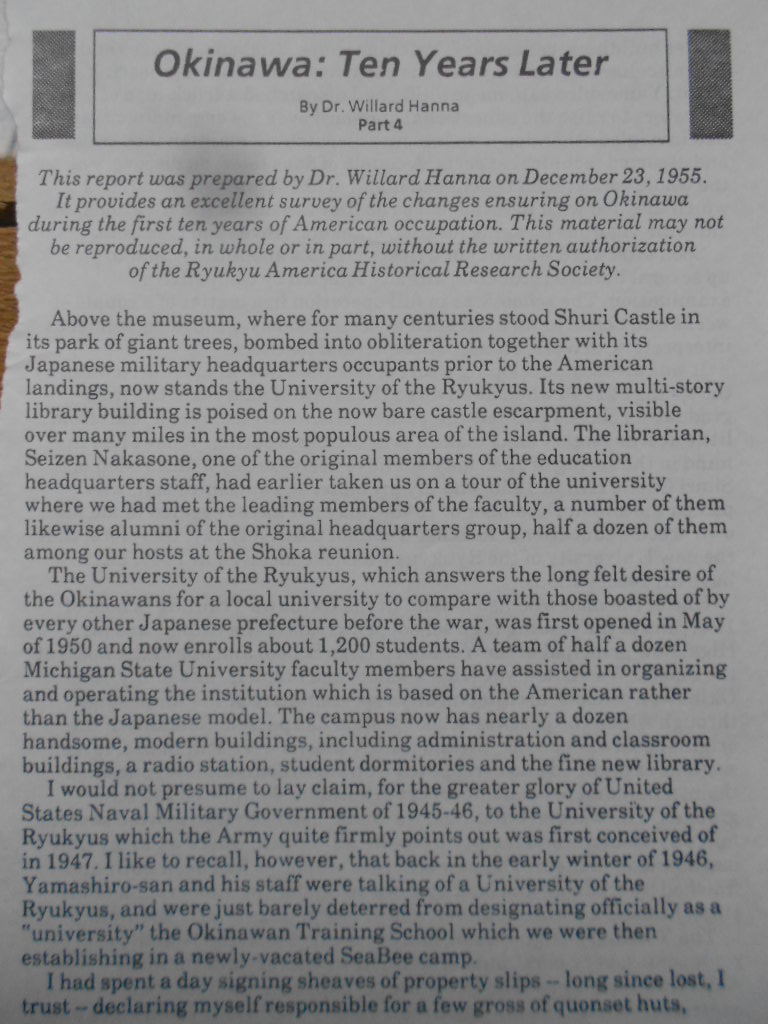
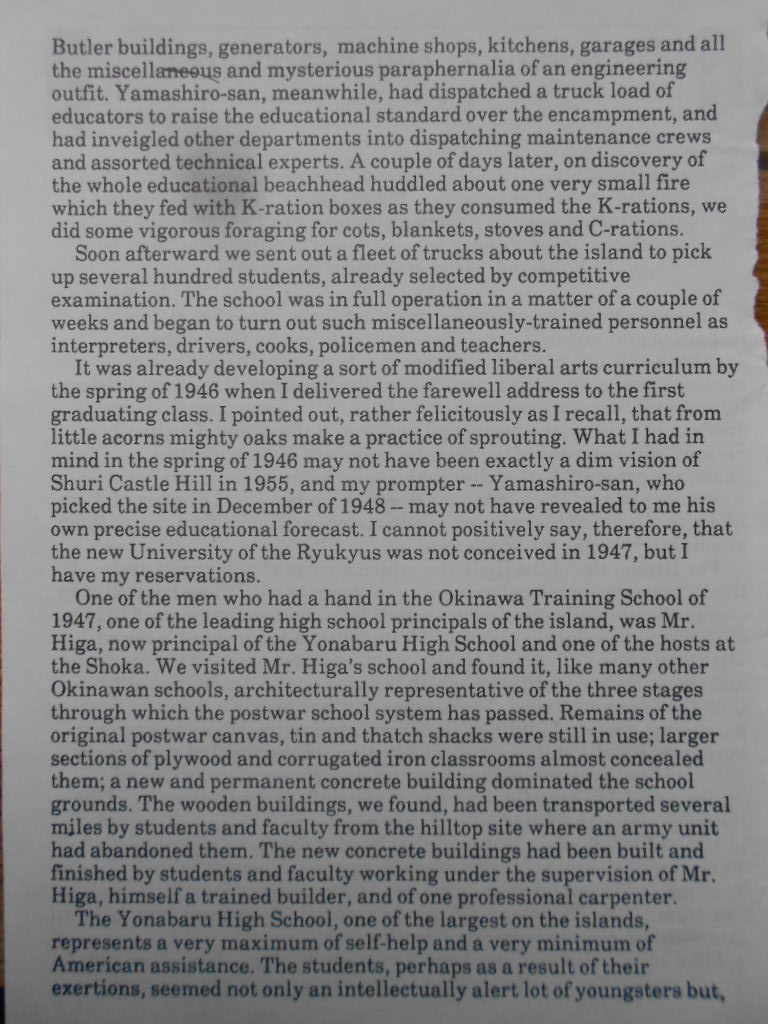
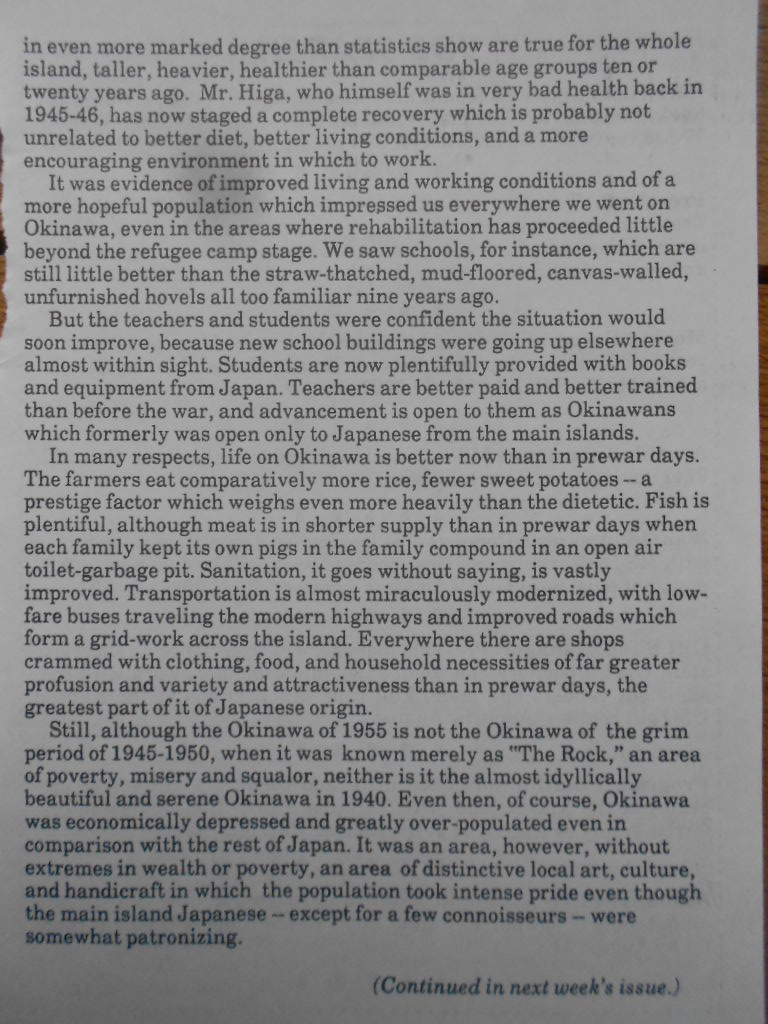
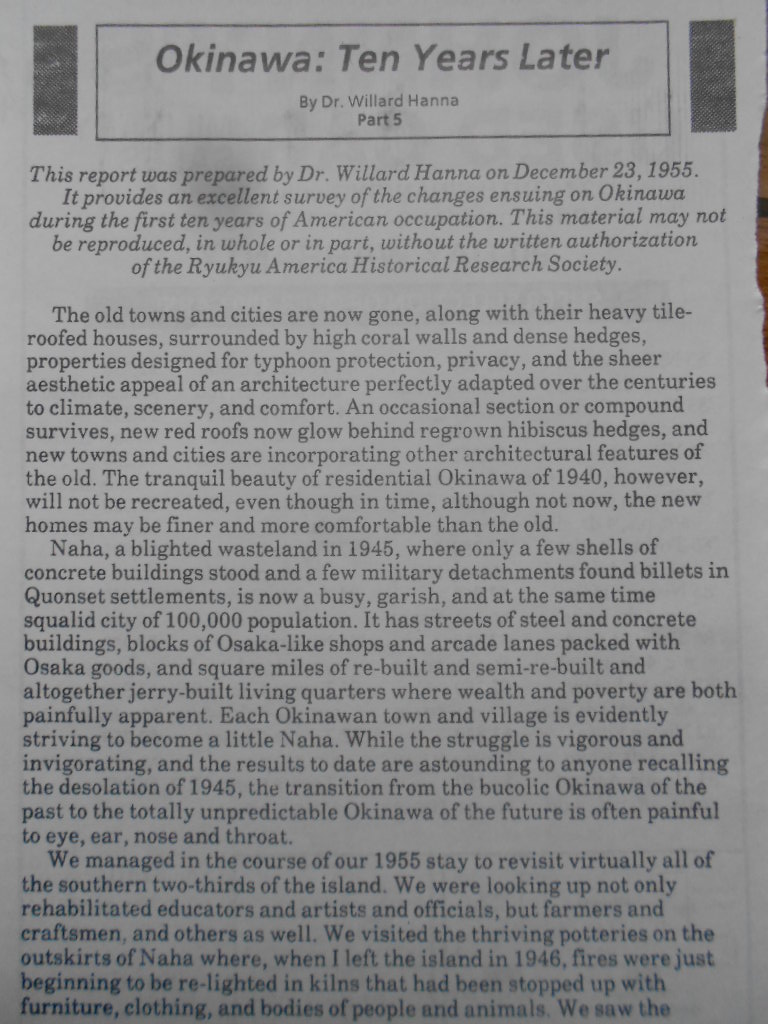
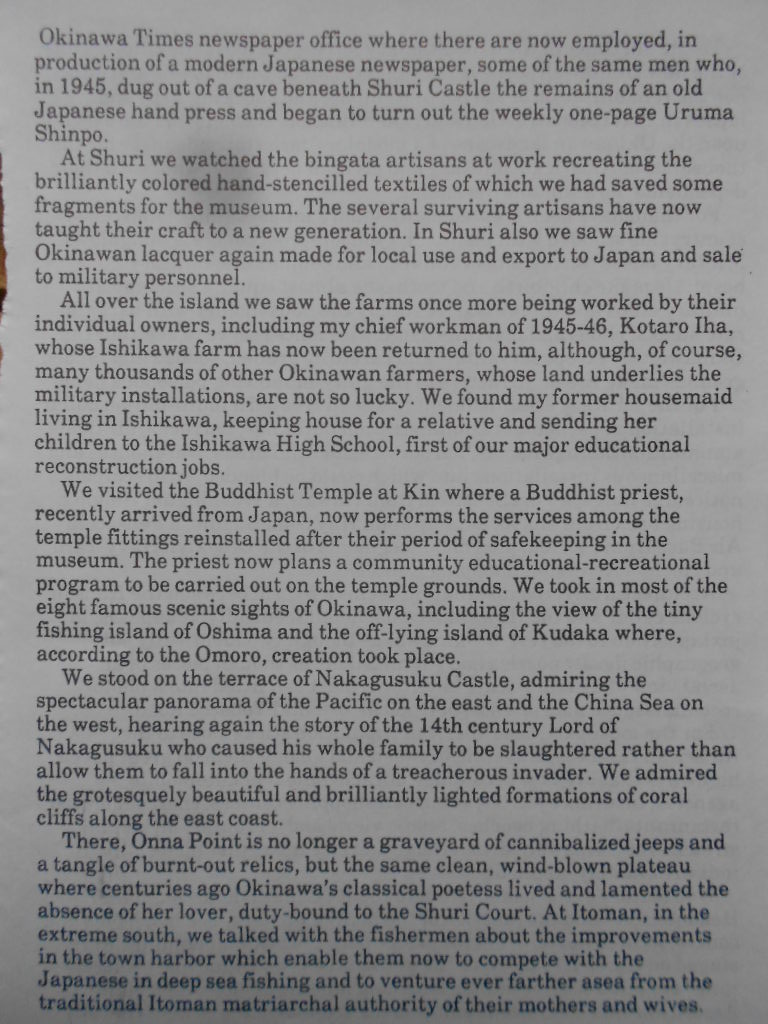
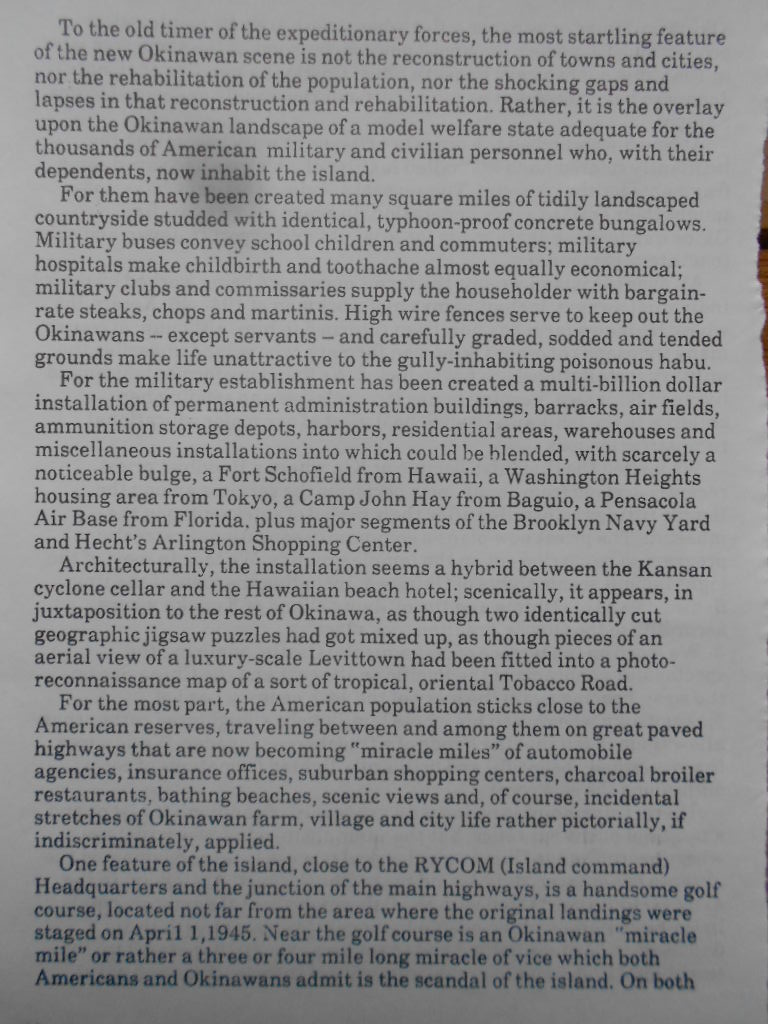
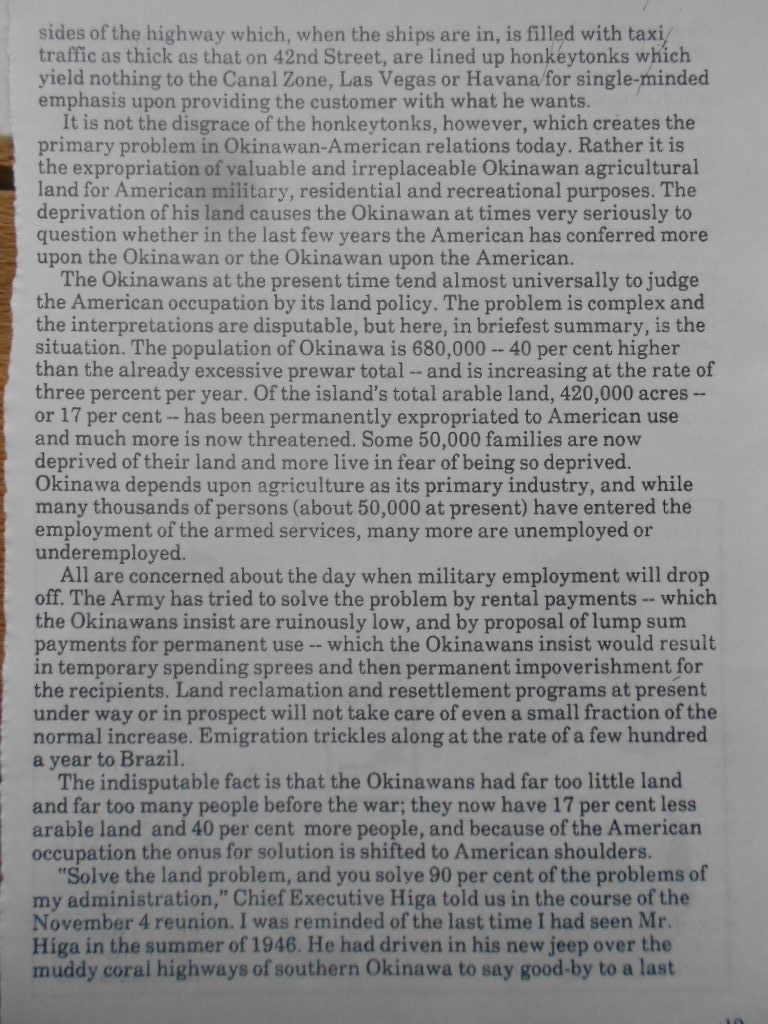
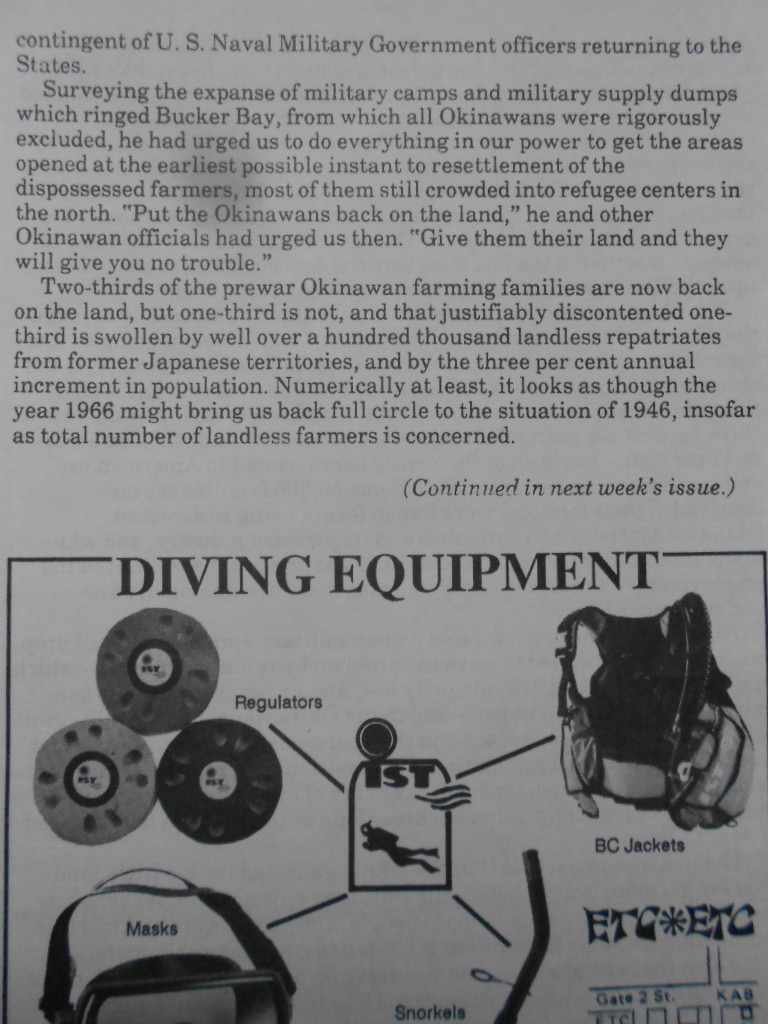
|
Solution to the problem has so far defeated the best efforts of the best-intentioned American and Okinawan authorities. Rental or purchase is no answer. In view of the tremendous American security and investment consideration, neither is American withdrawal a conceivable answer, if, indeed, a feasible one.
A solution--if any--to the Okinawan land problem is bound up in a solution--if any--to the even more fundamental and more perplexing problem from which the land issue, perhaps happily, has for many months been distracting attention. The major problem of Okinawa, the underlying problem in all Okinawan-American relations is simply this:, what sort of status are we going to confer upon Okinawa and the Okinawans?
Will Okinawa revert to Japan, and if so when, and in the interim, with what phasing out of American and phasing in of Japanese influence and authority? Will it remain, as Secretary Dulles states, "for the foreseeable future" under American control, and if so, with what political, economic and cultural conditioning and to what end? Is it to be regarded as a dependency, a colony, a trust, a possession--and with what provisions as to the rights of citizen, subject or charge? Are its people to be educated, as the Army expressly declares, in democratic principles and practices, and if so, then for eventual reversion to Japan, which many think is not particularly democratic, for all of General MacArthur's rhetoric; or for performance of relatively menial services for the American military installation; or for independent self-government which might lead first of all to demand for American departure?
There can be no question but that the great majority of the thinking Okinawans look forward to reversion to Japan and the sooner the better, but only after prior American provision for economic viability. There is no question also but that they are deeply worried about such problems as those which I have mentioned, but that for the time being they are concentrating most of their political energies upon the land issue. Several years ago, it was the reversionist issue. In a year or two it may be another. Happily, for both Americans and Okinawans, most of them are acting upon Chief Executive Higa's advice, frequently reiterated to a highly political legislative assembly that is understandably less receptive than the private citizen. His advice is to concentrate effort upon the problems which actually can now be solved and to have confidence that good-willed American and Okinawan efforts can bring amelioration of the others.
Wherever we went in Okinawa we observed the reassuring spectacle of Okinawans of many levels and many occupations actively and hopefully engaged in solving their own immediate problems in their own way, recreating for themselves a reasonably comfortable and happy life on an island where concentration upon the major political issues could lead only to frustration.
Chief Executive Higa himself, in the prewar period a school teacher by profession, in the postcombat period one of the first Okinawans to receive, as reward for his services, a home, an office, a jeep and some amelioration of privation, now accepts as a civic responsibility the impossible job of placating both an elective legislative assembly and a supervisory Army Command which can command the Executive and veto the legislation. The job is one which would seem either to attract or to create the agile, opportunistic politician; but Cief Executive Higa miraculously remains simple, honest, friendly and effective. He manages, without apparent susceptibility to stomach ulcers, to consort cheerfully with flocks of generals and chicken colonels from "Buzzards' Roost," the high brass quarters near RYCOM; with coveys of American Congressmen on investigation or junket bent; with unruly legislative assemblies given to passing resolutions on matters they are forbidden to legislate; with petition-bearing constituents; and, of course, with the unending procession of more or less legitimate, more or less casual visitors like myself.
I had been hesitant about returning to Okinawa to look up old friends. Several times in the postwar years I had passed over the island, stopping only an hour or so at the airport. I had heard all too much about the dismal period of 1946-50 when progress, if perceptible, was appalingly slow. In the last several years, I had read all too often the Japanese press allegations that the Okinawans were still living in shameful squalor and misery. So when I did finally return, I was very happily surprised.
Civilian reconstruction and rehabilitation have not proceeded one-half as far as they could and chould, if, in the multi-billion American foreign aid program, more than a relatively minute ten million were now being spent annually for Okianwa. The island might become a Pacific showplace, justifying rather than challenging our area-wide policy. But if Utopia has not arrived, neither has neglact been as great as I had feared. When I left Okinawa in the summer of 1946 Iwas, on the whole, proud of the American record. That record could have been infinitely better, of course, if those of us responsible for it had been equipped with superhuman foresight, energy and dedication. When I left again on November 6, 1955, I was again, on the whole, proud of the record. I was rather wistful, however, on behalf of my latter-day colleagues for that superhuman foresight, energy and dedication that might, at this point induce an American acceptance of what seems to me an incontrovertible fact.
That fact, in very categorical terms, is that the underlying Okinawan problem is an American problem too; sooner or later, and it might as well be sooner, we must set about seriously considering it, the problem is this: what are we going to do with Okinawa? Or, in human terms, what are we going to do with the Okinawans who, like Chief Executive Higa, and Yamashiro-san, and Yamada-san, and Kotaro the farmer, have been spectacularly patient and industrious, and--under the most adverse circumstances--cheerful and friendly?
In the world-wide context, the problem is both large and small. It is big enough to be important to our position in the whole Far East; it is small enough to be susceptible to great amelioration. The amelioration might begin with mere determination of Okianwa's prospective long-term administrative status, whether civil or military, whether Japanese of American, to what degree dependent or independent. |
Willard Hanna, LT. Commander, U.S. Navy (Ph.D. from the University of Michigan 1939) was the supervisor for the Military Government Section of Educational and Cultural Affairs and along with James Watkins, LT. Commander U.S. Navy, (Ph.D from Stanford 1941) worked en-thusiastically to protect and promote Okinawan culture and support the Arts and Monu-ments Department of the Okinawa Advisory Council.
Donn Cuson has a wonderful research paper (in .pdf format) regarding the work of Dr. Hanna and the
HIGAONNA (HIGASHI ONNA) MUSEUM
ISHIKAWA 1945-46. It's a good read!
[Back] to This Week On Okinawa issues
|